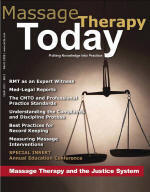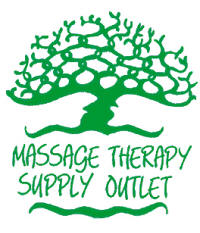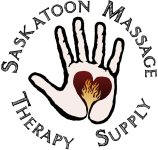|

Community,
Commentary and Curriculum
for Massage Therapists
How Vulnerable is the Massage Therapy
Profession to Economic Changes?
Massage Therapist Incomes and Injuries
Health Care: Are We In or Are We Out?
Extended Health Plans: Are We Too Reliant?
How
Massage Franchises and Spas are Affecting Massage Therapy
Practice
Some Good News for a Change!
Posted: March 2, 2009
Feedback
comment@mtcoach.com
Given the gloomy forecasts we've been pelted with - including my
commentary in the previous five posts - I believe it's time for a
healthy dose of optimism.
The truth is that there are tremendous opportunities in our industry,
especially if we align with health care and corporate wellness
initiatives that have contributed to our industry's growth in the first
place. Read on
Integration
into Mainstream: Massage Therapy in Hospitals
In
a 2003 survey conducted by the American Hospital Association on
the use of complementary and alternative medicine (CAM), 82% of
hospitals utilizing CAM included massage therapy as a form of
treatment for patients. An article in the Los Angeles Times
reports:
“Hospitals and medical clinics
around the United States are beginning to integrate massage into
patient care. Massage is currently the most common
non-traditional therapy offered in U.S. hospitals, according to
an American Hospital Association survey in 2003. The
most common uses for massage in hospitals: helping patients cope
with pain and stress, and as a therapeutic service for cancer
and maternity patients.”[i]
“At Martha Jefferson Hospital in
Charlottesville, VA, cancer patients are offered therapeutic
massage by one of eight trained therapists. Longmont United
Hospital in Colorado has a massage therapist on staff around the
clock for patients who need or request it.
At Memorial Sloan-Kettering
Cancer Center in New York, 11 massage therapists are on a staff
team working with hundreds of patients admitted to the hospital
or seen at its various clinics. And at the UCLA Center for
East-West Medicine, a team of four therapists uses massage to
alleviate pain and symptoms for patients suffering from
illnesses such as fibromyalgia, migraines and back pain.”
Dr. Ka-Kit Hui, director of
UCLA’s East-West Center in Santa Monica, CA, goes further:
“Massage is a very important therapeutic approach which is
underutilized and under-appreciated. A lot of people think
massage is good for aches and pains. But what we have found is
that massage activates the body’s own healing system.”[ii]
As our
Canadian government opens the door to a parallel private and
public health care delivery system, there may be more
opportunities for massage therapists to work in the mainstream
medical system.
Workplace Wellness – Is This the New Funding Source?
If the
funding for massage therapy via extended health care and auto
insurance rehabilitation plans continues to decline, how will
massage therapists be reimbursed for the services they provide?
One answer may lie in the world’s perhaps most abundant source
of funds – the corporate world.
According
to an annual article appearing in the publication Working
Mother, of the “100 Best Companies to Work For”, 77% of
these companies provided massage therapy treatments as a benefit
of employment. Massage Therapy Journal looked further to find
the highest users of corporate massage are the finance industry
(24%), followed by the high tech industry (21%) and the
insurance industry (19%). Most programs were set up on-site
with table and chair massage, where the company negotiated a
reduced rate for employees.
Interestingly, of the companies that did initiate these
benefits, only 18% reported initiating the programs because they
were approached by a massage therapist. Thirty percent were
generated by employee interest, and 39% were generated by the
company on its own initiative. It appears this is a great
untapped opportunity for entrepreneurial practitioners.
 Michael
Leahy, chiropractor and originator of Active Release
Techniques™, has found that many large companies embrace the
idea of using effective on-site intervention to lower employee
rehabilitation and compensation costs while improving their
bottom line. Michael
Leahy, chiropractor and originator of Active Release
Techniques™, has found that many large companies embrace the
idea of using effective on-site intervention to lower employee
rehabilitation and compensation costs while improving their
bottom line.
“There have been several
instances where corporations, insurance companies and
professional sporting teams have contacted (the ART head office)
for lists of providers. Obviously when such situations arose we
referred them to the most accomplished provider in their area.
We realized that we could help more patients and ART providers
by handling these situations differently. So we formed the ART
Elite Provider Network (EPN). This is a clinically integrated
network of the most experienced ART providers in each state and
province. The EPN was formed so that ART can guarantee the
highest quality of soft tissue care to large private industries,
insurance companies, and sporting organizations.”[iii]
“Never before has a provider
network been formed with a focus on quality of care.
Traditionally physician's groups negotiate contracts by cutting
their fees. We feel that ART already saves companies a
tremendous amount of money, so we do not reduce our rates to
acquire business. We focus on
savings through outcomes. We have and are successfully
negotiating contracts with many large corporations and we are
placing providers in these companies to treat employees for a
fixed number of hours a week. Each contract is different and
compensation amounts may vary, but in all instances the ART
providers are reimbursed well for delivery of care.”
One company
cited an 81 % reduction in worker’s compensation costs. In a
quote from the director of this company, “The ART program was
recognized by OSHA (Occupational Safety and Health
Administration, US Dept. of Labor) as the best practice for
treating strain/sprain injuries as a preventative measure.”[iv]
To provide
a sense of this problem in Canada, we reference a research paper
at the Stats Canada website. The author reported “in 2000/01,
10% of Canadians aged 20 or older, an estimated 2.3 million
citizens, reported having had a repetitive strain injury (RSI)
in the past 12 months. Work-related activities were most often
the cause. People with RSIs had more contact with health care
professionals and higher levels of chronic pain and
psychological distress than did those without an RSI.”[v]
Our
industry can create new opportunities by providing services to
businesses, reducing their health care claims and improving
employee quality of life. With the evaluation of these
practices and their benefits, more opportunities may become
available to therapists, including educational opportunities in
postural and movement re-education and workplace ergonomic
evaluation.
But there’s
a price to pay for these opportunities. We must show efficacy
with evidence-based outcomes, and utilize pooled resources to
advocate interests.
Professional
Associations Provide Leverage
When
people ask me why they should be a member of a professional
association, my short answer is “leverage”. Leverage is the
ability to use collective talents, abilities and resources to
generate larger gains. My longer answer speaks to five key
areas that, as a sole practitioner, I would have a great deal of
difficulty initiating myself. These are:
Information – A
professional association can provide accurate and prompt
information about the issues I need to know about. Better
information means I can make better decisions.
Advocacy
– I want my professional concerns brought effectively before
government, the insurance industry and allied health
professionals. My professional association has the time and
resources to do this much more effectively than I do.
Public
Relations - I want my
association to actively educate the general public and the
afore-mentioned agencies on a regular and consistent basis.
Expansion of opportunities
- by investing in research and building alliances, my
association can open new doors for me and my colleagues.
Professional Development
– I want high-caliber, international experts brought centrally
to association events so I can learn straight from the masters.
My professional association can organize this for me.
Many
professional associations in our industry may be struggling to
find and keep active members. Membership dues finance the
above-mentioned initiatives which, on an individual practitioner
basis, would be difficult or impossible to do. If all of us,
across this whole country took this one initiative, it would
have a dramatic effect on the profession…join and maintain your
membership in your professional association.
We Can Align
with Complementary Industries and Pool Resources
Of course
it’s not necessary to do all the work alone. There are many
complementary industries, such as the health and fitness,
competitive sports or the anti-aging industry, occupational
health and rehabilitation industries that serve the same markets
as our profession. By taking advantage of co-marketing and
education efforts, we can effectively serve these markets
better, with costs associated with education and research
apportioned over a greater number of providers.
Doctor
Julia Alleyne, in her article “Welcome to Wellness: An
Opportunity for Fitness and Medicine” posits “Perhaps the time
has come to connect the fitness and health care industry
together in a joint action plan of education, service delivery
and preventative medicine.”
“I would
like to see a Wellness Package that includes a monthly fee for
health services that would be used over the year for prevention,
performance or treatment. A wellness coordinator would meet
with all clients and set out a plan for achieving an improved
state of health and wellness over the year. Services such as
massage therapy, dietary consultations, injury prevention
assessments, stress management strategies and ergonomic
assessments are a few of the gems that would be included in the
package. A seamless transition from fitness to health and back
again.”[vii]
According
to a 2001 Health Canada study, companies that invest and
encourage in-house fitness and wellness programs experience a
direct economic benefit. The study found employees in these
programs experienced: improved fitness and health, increased
productivity and better morale, higher job satisfaction and team
spirit, less absenteeism from work or the desire to seek
employment elsewhere, and less work-related injuries. This of
course all equates to lower WSIB claims, lower turnover and
higher company profits. A study by national health insurers
showed a return of $1.64 for every dollar a business spends on
improving the health of its employees.
Husky
Injection Molding Systems Ltd. of Bolton, Ontario knows this.
Husky’s employee benefits include an on-site fitness centre with
fitness classes, a healthy-choices cafeteria, daycare services,
and an on-site health clinic providing naturopathic,
physiotherapist, physician and massage therapist services.
Husky’s absenteeism, turnover rate and injury claims are
significantly lower than the industry average, with a 1998
estimated savings of $9 million from recycling, energy
reduction, lower injuries, absenteeism and insurance claims.
Thinking
outside the box, our profession may entertain questions such as
“Who can we align with to meet our objectives? What would
partners gain in aligning with us?” By aligning with
complementary industries, we may be able to get more work done,
faster, at proportionately less cost.
Closing
So, by
aligning with complimentary industries and rethinking our
approach to providing care, massage therapists can continue to
provide high value, quality care especially when health, worker
productivity and quality of life are most valued.
© 2009, Donald Q. Dillon, RMT. All Rights
Reserved.
No part of this article may be reproduced, stored
in a retrieval system, or transmitted in any form or by any
means, electronic, mechanical, recording or otherwise, without
the prior written permission of the author.
Send your
feedback to
comment@mtcoach.com
[i]
MacGregor, H.E: Los Angeles Times, 12-28-2004. Hospitals
Getting a Grip: Massage Therapy Finds Place in Patient
Care for FM and More
[iv]
Betsch, M: Active Release Techniques – One Company’s
Solution for Solving Strain/Sprain Injuries. The
Leader, Autumn 2004
[v]
Tjepkema, M: StatsCan Vol. 14, # 4
[vi]
Dryden, T and White, M.: The Canadian Massage Therapist
Alliance Research Network (CMTARN): National Task Force
on Outcome-Based Massage. Journal of Soft-Tissue
Manipulation, Vol 12, # 3 (Spring 2005), pp 3-5
[vii]
Alleyne, Dr. J: Welcome to Wellness. Fitness Business
Canada July/August 2005, pg 70
Wonder what your
Colleagues are thinking?

Join the Dialogue
|
















